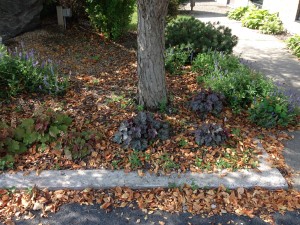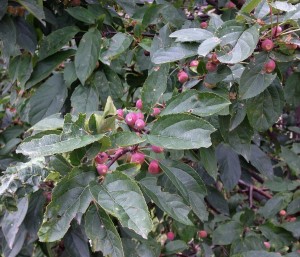Crabapples, ornamental pears, and ash have all been losing foliage through July and August (Figure 1). The leaves that are falling are infected with apple scab, apple rust, pear scab and anthracnose. All the diseases are fungi that infect newly forming leaves in the early spring. Unfortunately, at this point of the season there aren’t any effective treatments to prevent continuing defoliation.
(Figure 1)
The wet spring and continuing precipitation into the summer provided the ideal environment for all of these fungi to spread spores and infect the new lush leaves that were pushing out of the buds. The leaves, once infected with the fungi cannot be cured (Figure 2). Throughout the rest of the growing season, the fungi spread through the leaves feeding on the living cell tissue. As the hyphae of the fungi spread they create lesions of dead tissue on infected leaves and fruits (Figure 3).
(Figure 2)
(Figure 3)
Eventually when the entire leaf has died, it senesces and falls from the tree (Figure 4). This defoliation over many years will impact the appearance of the trees (Figures 5 & 6), and can impact the health of the trees by reducing photosynthetic uptake. The fallen leaves also harbor and protect the fungus through the winter. After the winter, the fungi in the dead leaves create spores that are spread by air movement and water splashes to infect new tissues. While this is the primary form of spore disbursement, infected leaves that remained attached to the tree and branches that held infected foliage will also spread the disease inoculum the following spring.
(Figure 4)
(Figure 5)
(Figure 6)
Plant breeding programs have developed many cultivars of plants that are “resistant” to foliage diseases. Many new crabapple cultivars have been propagated for their resistance to apple scab (Figure 7). Typically, this resistance lasts for up to ten years, after which the scab fungi adapt to overcome the resistance traits. Planting of scab resistant crabapples is recommended, but it should be noted that they will eventually succumb as the resistance traits will be overcome through the adaptation of generations of scab fungi.
(Figure 7)
Besides breeding resistance into trees, currently, the only way to manage these fungal diseases is to prevent them from infecting the foliage. Removing the fallen leaves from around the tree will reduce the number of spores that will disperse next spring, but won’t be enough to prevent infections in susceptible trees.
The application of fungicides in the spring is the most effective method to preventing infection. Fungicides are applied to create a barrier around the leaf that kills any spores trying to germinate on the surface of the leaf. In wet years, like this one, it may be necessary to repeat treatments as new foliage expands and rain keeps the new tissues wet. Any foliage that isn’t protected with a fungicide can be infected. Again, once the leaf is infected, there are no treatments available to cure the infection. Thorough coverage of leaves with fungicides is required. And, the timing of the applications is crucial to the successful prevention of infection.
The plant health care professionals at Ostvig Tree Care have been treating trees for these diseases for many years. They have the equipment and the knowledge to protect trees of any size. They also know how to diagnose all the foliar disease problems that can occur on trees in the Twin Cities.
If you are concerned about the leaves dropping from your trees, please call an Ostvig Tree Care expert to determine what may be causing the problem with your tree. While leaf drop from spring fungal infections is common this time of year, other factors can contribute to early leaf drop. Many of these other factors can be serious health risks for your tree.
Dr. John E. Lloyd, Ph.D. is President of Plant Health Doctors, LLC in the Twin Cities. He can be contacted through Ostvig Tree Care at info@OstvigTree.com.














